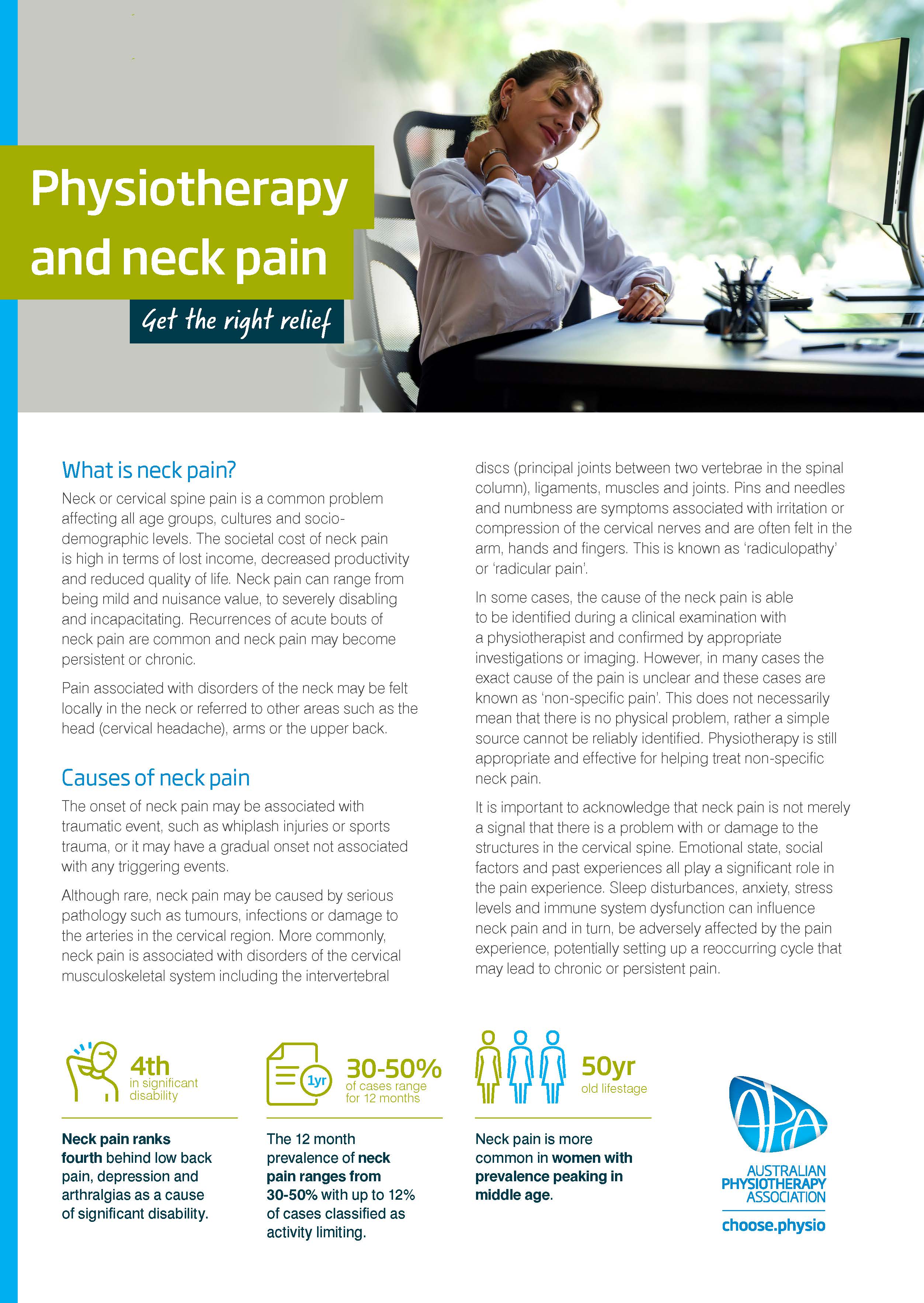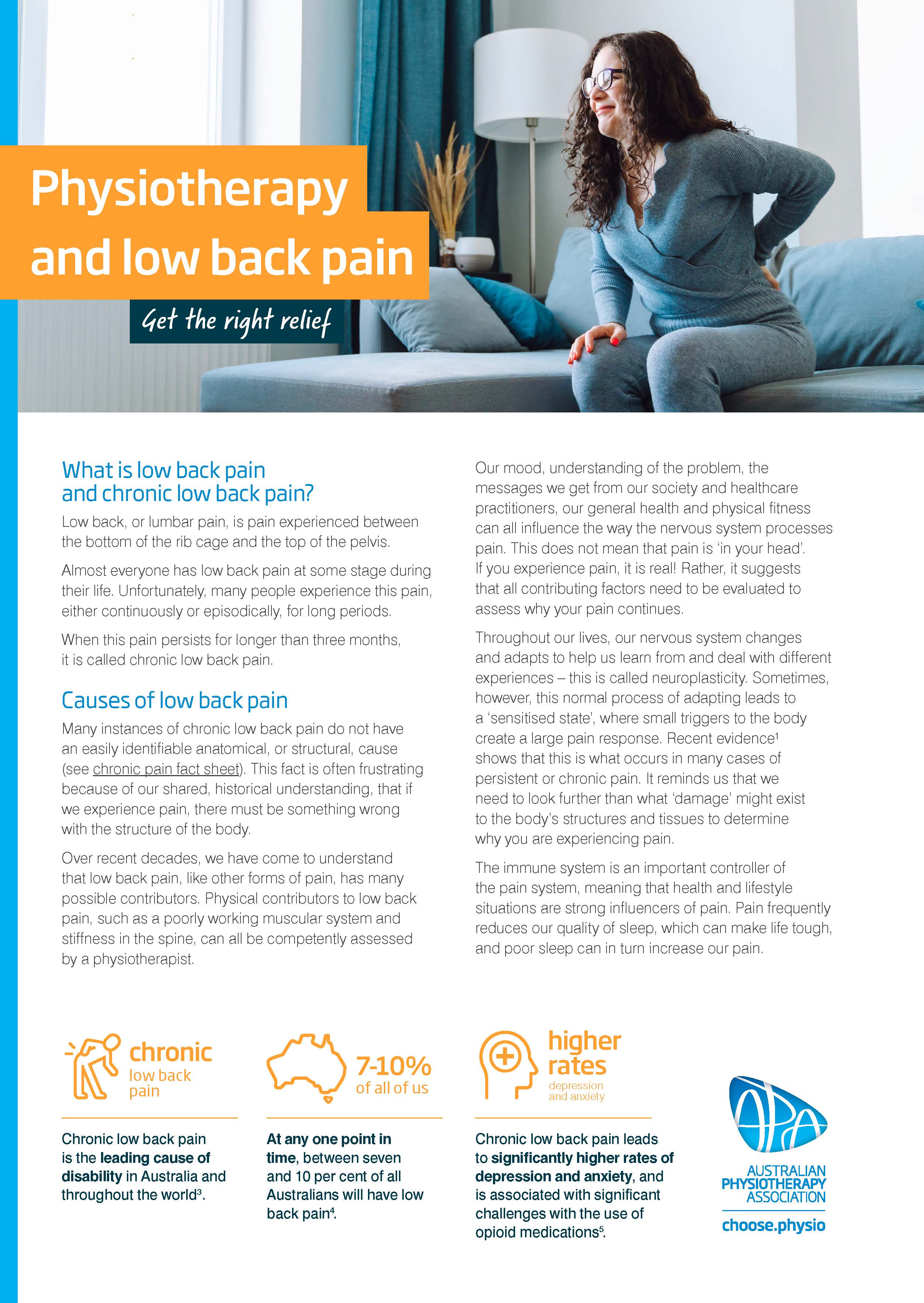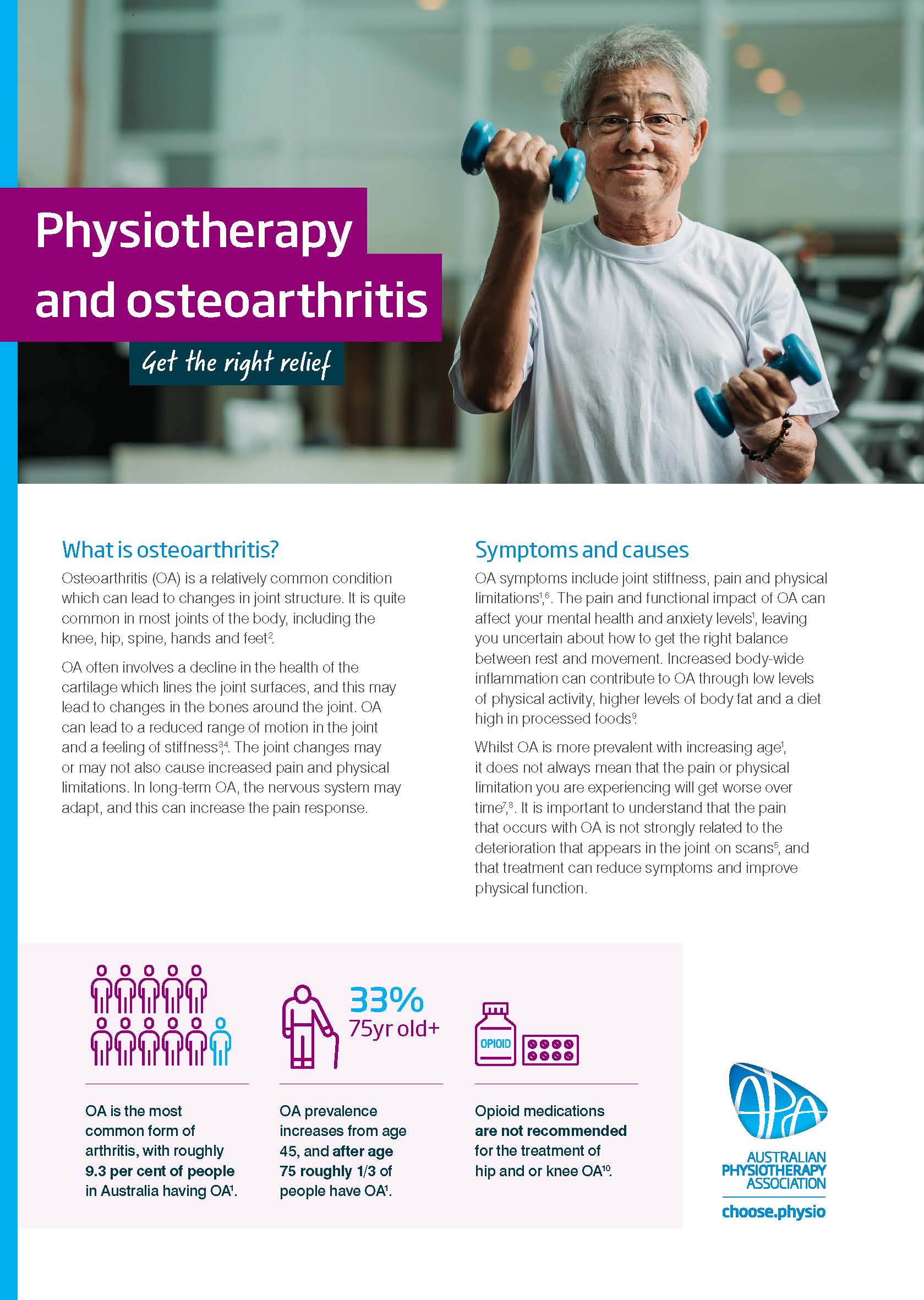Pain is a very common experience for us all. When we reflect on these numerous instances of pain we experience each day, they mostly come quickly and go just as fast. Many of them make very good sense to us – we bump or injure ourselves in some way, pain alerts us to this, we protect the injured area and the pain goes away. This short-lasting pain is called ‘acute pain’.
However, pain can become long-lasting and this is called ‘chronic or persistent pain’. Chronic pain is defined as pain lasting for three months or longer, on a mostly continuous basis. There are some situations where chronic pain is due to ongoing injury or illness affecting the body’s structures and tissues. However, for most people experiencing chronic pain, there is no evidence of continuing injury. A simpler way to think about chronic pain is where pain exists after healing has finished.
A physiotherapist can assess your condition and provide tailored advice and treatment to help you to get the right relief.

--Spotlight on Chronic Pain
Every person with chronic pain is different in both their presentation and goals. Your physiotherapist will utilise the evidence base, their clinical expertise and specific presentation and concerns, to determine the best management plan for you.
Click the image to download the factsheet.
--Spotlight on Neck pain
Almost everyone has neck pain at some stage during their life. Neck pain can range from being mild and nuisance value, to severely disabling and incapacitating. Recurrences of acute bouts of neck pain are common and neck pain may become persistent or chronic.
Physiotherapy treatment is always ‘patient-centred’, ensuring you are informed and respected in the decision-making process.
Click the image to download the factsheet.
--Spotlight on Low back pain
Almost everyone has low back pain at some stage during their life. Unfortunately, many people experience this pain, either continuously or episodically, for long periods. When this pain persists for longer than three months, it is called chronic low back pain.
Chronic back pain stops people from moving. Physiotherapists can help you participate in life’s activities, in a safe way, and empower you to be the driver of your own progress.
Click the image to download the factsheet.
--Spotlight on Osteoarthritis
Osteoarthritis (OA) refers to a painful joint condition that is the result of a number of movement, lifestyle and genetic factors that progress as you age. OA is the most common type of arthritis, affecting 9.3 per cent of Australians.
High-level evidence shows that exercise and physical activity are key to reducing inflammation and pain and improving function. Your physiotherapist will help you to determine what level of activity is enough to challenge your body and your OA joint, but not enough to cause a flare in symptoms.
Click the image to download the factsheet.
--What causes or contributes to pain?
Pain is created by the brain as it evaluates all incoming information. This means that pain is not only related to what is happening in our body structures and tissues, but also our mind. Our mind explores damage to the body, but also houses our emotions, our memory, our beliefs and concerns, and it does all these things in the context of the world in which we live – our relationships, workplace, family and friends. So, our brain needs to consider all these things before it makes us aware of pain.
This does not mean that the pain is ‘all in your head’. It rather suggests that all contributing factors need to be evaluated to assess why your pain continues.
We also know that the immune system is an important controller of the pain system, meaning that health and lifestyle situations are strong influencers of pain. Pain frequently reduces our quality of sleep, which can make life tough, and in turn poor sleep can increase our pain. Also, reducing activity levels when you are in pain can lead to an increased intensity of pain.
--Why does pain persist?
Throughout our lives our nervous system changes and adapts to help us learn from and deal with different experiences – this is called neuroplasticity. Sometimes however, this normal process of adapting leads to a ‘sensitised state’, where small triggers to the body create a large pain response. Recent evidence¹ shows that this is what occurs in many cases of persistent or chronic pain.
Many people are lead to believe that because the pain is coming from the nervous system, that it is just ‘pain in your head’. However, the opposite is indeed true. If you experience pain, then it is real! However, as pain involves the whole nervous system, it reminds us that we need to look further than just what damage might exist to the body’s structures and tissues to work out why you are experiencing pain.
--How common is chronic pain?
Chronic pain affects approximately 20-30 per cent of people across all age groups². Many people can function very well despite the ongoing pain, while others find the pain very limiting, with significantly higher rates of depression, anxiety, lower quality of life, reduced work status and higher rates of suicide². Chronic pain imposes a very large burden on the Australian economy, costing around $150 billion each year². According to World Health Organisation Global Burden of Disease data, chronic pain is one of the leading causes of disability in adults throughout the world².
--How do we treat and manage pain?
Physiotherapy treatment encompasses all evidence-based treatment options which are non-pharmaceutical and non-surgical in nature.
There is no ‘one-size-fits-all’ for chronic pain and your physiotherapist will work with you to explore all the possible options and advise you what management is best for you. They will also clear up misinformation or confusing advice you may have received. Frequently in chronic pain patients, hands-on treatments are not as successful as they might be in acute pain. Therefore, developing an effective exercise and activity regime will be essential. This can help you to reduce pain, improve flexibility and strength and regain your confidence to move.
Pain management may involve a team of healthcare providers, including GPs, physiotherapists, nurses and other allied health practitioners, such as clinical psychologists.
--What role does physiotherapy play?
Physiotherapists with a special interest in managing pain are well-placed to provide education on the complexities of pain and how the nervous and immune systems work. They will conduct a thorough assessment of the possible contributors to your pain experience. These may include the strength and flexibility of the body, your goals and personal situation and your understanding and the expectations you have regarding your pain.
Your physiotherapist will assess the impact that pain is having on your life and assist you with many of those challenges. Developing a better understanding of your pain forms the basis for then developing and progressing an appropriate and tailored plan.
Physiotherapy management is always ‘patient-centred’, making sure that you are involved and respected in the decision-making process. Research shows that education and treatment which empowers you is a huge and effective part of chronic pain management. There is also convincing evidence that exercise, physical activity, accurate education and strong therapeutic relationships with physiotherapists assist people to significantly improve their chronic pain.
Chronic pain often stops people from moving, however physiotherapists have the skills to work out how to get you participating in life’s activities in a gradual and safe way, and will work by empowering you to be the key controller of your own progress.
Your physiotherapist will help you navigate the health system and orient you to the best health services for your situation. Pain, whether short-term or of longer duration, may have many contributing factors and consequences. Therefore, it is reasonable to expect that a multidimensional approach to managing it will be much more effective than a single approach, especially when pain persists.




